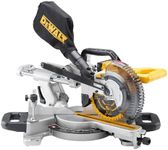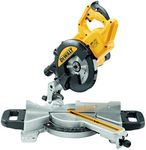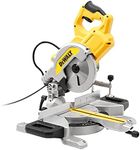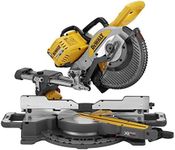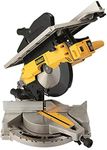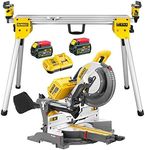Buying Guide for the Best DeWalt Miter Saws
When choosing a DeWalt miter saw, it's important to consider the type of projects you'll be working on and the specific features that will best suit your needs. Miter saws are versatile tools used for making precise crosscuts and angled cuts in wood, metal, and other materials. Understanding the key specifications will help you select a saw that matches your requirements, whether you're a professional carpenter or a DIY enthusiast.Blade SizeThe blade size of a miter saw determines the depth and height of the cut it can make. Common blade sizes are 7-1/4 inches, 10 inches, and 12 inches. A larger blade can cut through thicker and wider materials, making it suitable for larger projects like framing or cutting large baseboards. If you're working on smaller projects or need more portability, a smaller blade might be sufficient. Consider the types of materials and the size of the cuts you'll be making to choose the right blade size for your needs.
Motor PowerMotor power, measured in amps, affects the saw's ability to cut through different materials. Higher amp motors provide more power, allowing for smoother and faster cuts through dense materials. For heavy-duty tasks or frequent use, a motor with higher amps (15 amps is common for professional-grade saws) is recommended. For lighter tasks or occasional use, a lower amp motor may be adequate. Assess the intensity and frequency of your projects to determine the appropriate motor power.
Bevel CapacityBevel capacity refers to the saw's ability to tilt the blade to make angled cuts. Single bevel saws tilt in one direction, while dual bevel saws tilt in both directions, offering more flexibility and efficiency for complex cuts. If you frequently work on projects that require compound cuts, such as crown molding, a dual bevel saw can save time and effort. For simpler projects, a single bevel saw might suffice. Consider the complexity of your projects when deciding on bevel capacity.
Sliding vs. Non-SlidingSliding miter saws have a rail system that allows the blade to move forward and backward, increasing the cutting capacity for wider materials. Non-sliding saws are more compact and typically less expensive, suitable for narrower cuts. If you need to cut wide boards or panels, a sliding miter saw is beneficial. For smaller, more straightforward cuts, a non-sliding saw may be more appropriate. Think about the size of the materials you'll be cutting to choose between sliding and non-sliding options.
Cutting AnglesMiter saws can cut at various angles, which is crucial for tasks like framing, molding, and trim work. The range of miter angles varies by model, with some offering more flexibility than others. A saw with a wide range of miter angles allows for more versatility in your projects. If your work involves complex angles, look for a saw with a greater range. For standard cuts, a basic range may be sufficient. Evaluate the types of cuts you'll need to make to determine the necessary angle range.
PortabilityPortability is an important factor if you need to move the saw between job sites or store it in a small space. Lighter, more compact models are easier to transport and store, but may have fewer features or lower cutting capacity. If you work in a fixed location or have ample space, a heavier, more robust model might be preferable. Consider how often you'll need to move the saw and the space available for storage when assessing portability.
